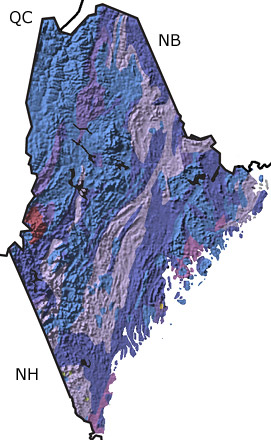Paleontology and geologyThe Precambrian and Cambrian: During the Precambrian and Cambrian, the land area now known as Maine was not yet in existence. The first parts of Maine were not assembled until the Ordovician when ancient landmasses were accreted to North America.
The Paleozoic and Mesozoic: During the Ordovician, Silurian, and Devonian, the current East Coast, including Maine, occupied a position south of the equator, and thus rocks from these time periods were formed in a tropical ocean. Marine habitats ranging from nearshore to deepwater were home to numerous invertebrates. Tectonic activity in the Devonian resulted in a mountain-building episode, followed by a time of significant erosion. Some Devonian deposits preserved terrestrial remains, largely in the form of fragmented plant fossils. Following the Devonian, Maine transitioned from a marine-dominated setting to a fully terrestrial one, reducing the potential for fossil and sediment preservation. In addition, erosion removed any post-Devonian deposits, and no fossiliferous deposits from the Carboniferous to the Late Tertiary (Pliocene) have been discovered in Maine.
The Cenozoic: Cenozoic deposits include both marine sediments and sediments left behind by melting glaciers. When glaciation peaked in Maine nearly 20,000 years ago, a thick layer of ice covered the state, depressing the crust beneath it. As the climate warmed, the glaciers retreated and seas flooded the depressed landscape. Once the landscape had sufficient time to rebound, the seas drained, and Maine transitioned to a fully terrestrial setting. The flora and fauna changed from cold weather species to the more familiar temperate forms that inhabit Maine today. |

